ignition SKODA YETI 2010 1.G / 5L Repair Manual
[x] Cancel search | Manufacturer: SKODA, Model Year: 2010, Model line: YETI, Model: SKODA YETI 2010 1.G / 5LPages: 271, PDF Size: 14.71 MB
Page 131 of 271

Communication
130
Connection with an already paired mobile phone
After switching on the ignition, the connec tion is automatically established for the
already paired mobile phone
10). Check on the mobile unit if the automatic connection
was established.
Disconnecting the connection
By withdrawing the ignition key.
By disconnecting the device in the information display.
By disconnecting the device in the mobile phone.
Solving connection problems
If the system announces No paired phone found , check the operating state of the
telephone:
Is the telephone switched on?
Is the PIN code entered?
Is Bluetooth
® active?
Is the visibility of the mobile phone active?
Was the telephone already paired with the hands-free system?
WARNING
In the event of air transport, the Bluetooth
® function of the hands-free system
must be switched off by a specialist garage!
Note
Not valid for all mobile phones which enable a communication via Bluetooth
®.
You can ask at an authorised Škoda Service Partner if your telephone is compatible
with the universal telephone preinstallation GSM II.
If a suitable adapter is available for yo ur mobile phone, use your mobile phone
exclusively in the adapter so that the radiation in the vehicle drops to a minimum.
Inserting the mobile phone into the ad apter ensures an optimal sending and
receiving power and offers at the same ti me the advantage of the battery charging.
The range of the Bluetooth
® connection to the hands-free system is restricted to
the vehicle interior. The range is dependent on local factors, e.g. obstacles between the devices and mutual interferences with other de
vices. If your mobile phone is e.g. in a
jacket pocket, this can lead to diffic ulties when establishing the Bluetooth
® connection
with the hands-free system or the data transfer.
Inserting the mobile phone with the adapter*Only one telephone mount* is factory-fitted. An adapter for the telephone can be
purchased from the range of the Škoda original accessories.Inserting the mobile phone with the adapter– First of all push the adapter fig. 119 in the direction of arrow up to the stop
into the mount. Press the adapter slightly downwards, until it locks securely into
position.
– Insert the mobile phone into the adapter (as specified in manufacturer's instructions).Removing the mobile phone with the adapter– Press simultaneouly the side locks of th e mount and remove the mobile phone and
adapter fig. 119 .
Caution
Taking the mobile phone out of the adapter du ring the call can lead to interruption of
the connection. When taking out the mobile phone, the connection to the factory-
fitted antenna is interrupted, this reduces the quality of the transmitting and receiving
signal. The charging of the mobile phone battery is also interrupted.
Fig. 119 Universal preparation for the
phone
AA
AA
s2ug.6.book Page 130 Friday, April 9, 2010 2:24 PM
Page 147 of 271
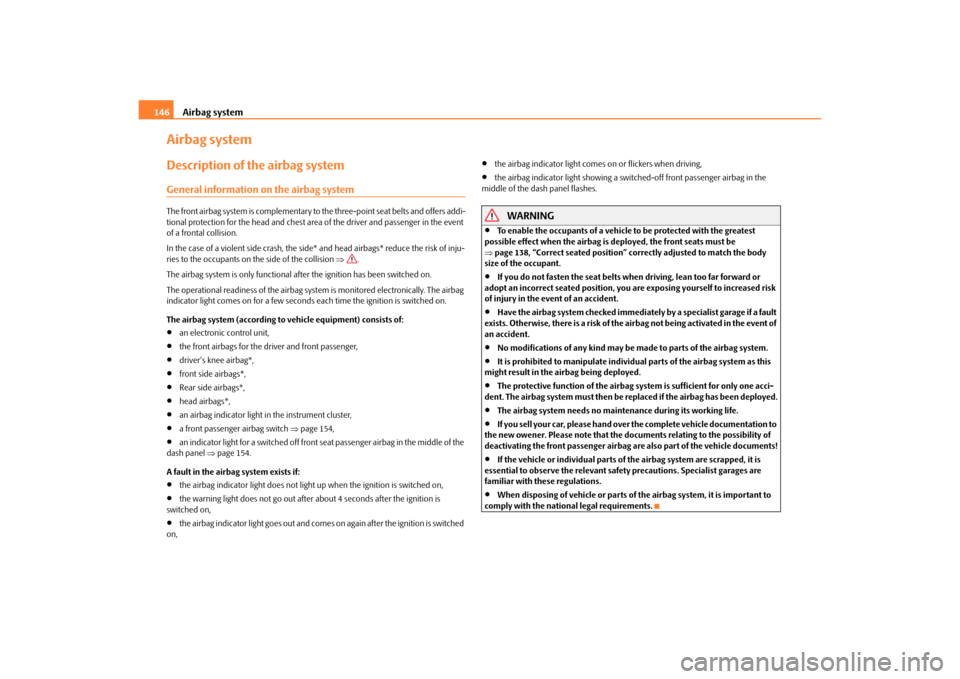
Airbag system
146
Airbag systemDescription of the airbag systemGeneral information on the airbag systemThe front airbag system is complementary to the three-point seat belts and offers addi-
tional protection for the head and chest area of the driver and passenger in the event
of a frontal collision.
In the case of a violent side cr ash, the side* and head airbags* reduce the risk of inju-
ries to the occupants on the side of the collision .
The airbag system is only functional af ter the ignition has been switched on.
The operational readiness of the airbag syst em is monitored electronically. The airbag
indicator light comes on for a few seconds each time the ignition is switched on.
The airbag system (according to vehicle equipment) consists of:
an electronic control unit,
the front airbags for the driver and front passenger,
driver's knee airbag*,
front side airbags*,
Rear side airbags*,
head airbags*,
an airbag indicator light in the instrument cluster,
a front passenger airbag switch page 154,
an indicator light for a switched off front seat passenger airbag in the middle of the
dash panel page 154.
A fault in the airbag system exists if:
the airbag indicator light does not light up when the ignition is switched on,
the warning light does not go out after about 4 seconds after the ignition is
switched on,
the airbag indicator light goes out and come s on again after the ignition is switched
on,
the airbag indicator light comes on or flickers when driving,
the airbag indicator light showing a swit ched-off front passenger airbag in the
middle of the dash panel flashes.
WARNING
To enable the occupants of a vehicle to be protected with the greatest
possible effect when the airbag is deployed, the front seats must be
page 138, “Correct seated position” co rrectly adjusted to match the body
size of the occupant.
If you do not fasten the seat belts when driving, lean too far forward or
adopt an incorrect seated position, you are exposing yourself to increased risk
of injury in the event of an accident.
Have the airbag system checked immediat ely by a specialist garage if a fault
exists. Otherwise, there is a risk of the airbag not being activated in the event of
an accident.
No modifications of any kind may be made to parts of the airbag system.
It is prohibited to manipulate individual parts of the airbag system as this
might result in the airbag being deployed.
The protective function of the airbag system is sufficient for only one acci-
dent. The airbag system must then be re placed if the airbag has been deployed.
The airbag system needs no maintenance during its working life.
If you sell your car, please hand over the complete vehicle documentation to
the new owener. Please note that the documents relating to the possibility of
deactivating the front passenger airbag are also part of the vehicle documents!
If the vehicle or individual parts of the airbag system are scrapped, it is
essential to observe the relevant safety precautions. Specialist garages are
familiar with these regulations.
When disposing of vehicle or parts of the airbag system, it is important to
comply with the national legal requirements.
s2ug.6.book Page 146 Friday, April 9, 2010 2:24 PM
Page 148 of 271
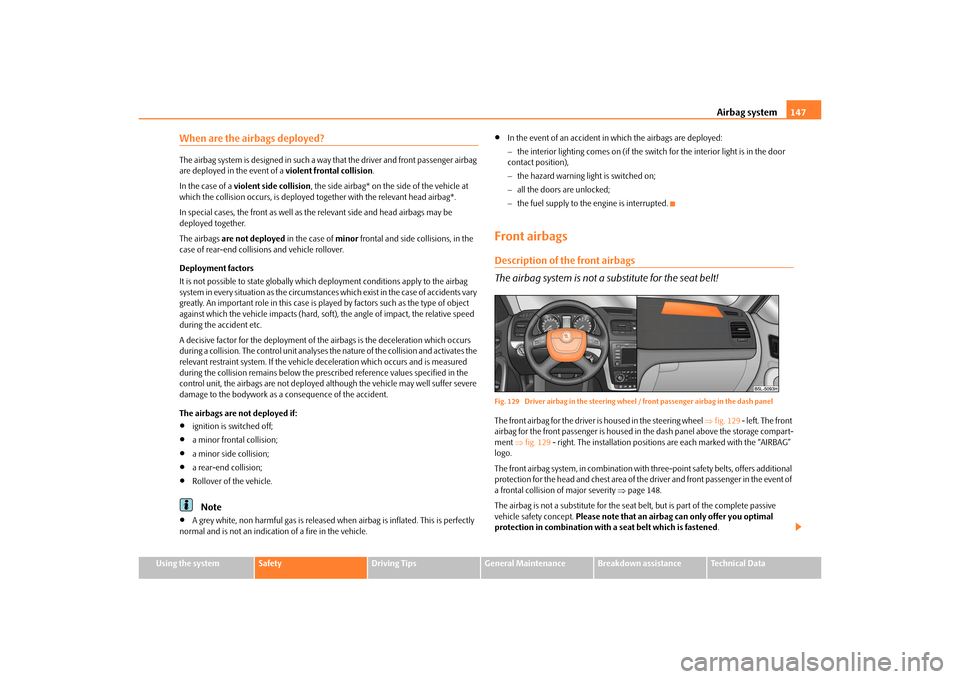
Airbag system147
Using the system
Safety
Driving Tips
General Maintenance
Breakdown assistance
Technical Data
When are the airbags deployed?The airbag system is designed in such a wa y that the driver and front passenger airbag
are deployed in the event of a violent frontal collision.
In the case of a violent side collision , the side airbag* on the side of the vehicle at
which the collision occurs, is deployed to gether with the relevant head airbag*.
In special cases, the front as well as th e relevant side and head airbags may be
deployed together.
The airbags are not deployed in the case of minor frontal and side collisions, in the
case of rear-end collisi ons and vehicle rollover.
Deployment factors
It is not possible to state globally which deployment conditions apply to the airbag
system in every situation as the circumstances which exist in the case of accidents vary
greatly. An important role in this case is played by factors such as the type of object
against which the vehicle impacts (hard, soft ), the angle of impact, the relative speed
during the accident etc.
A decisive factor for the deployment of the airbags is the deceleration which occurs
during a collision. The control unit analyses the nature of the collision and activates the
relevant restraint system. If the vehicle deceleration which occurs and is measured
during the collision remains below the prescribed reference values specified in the
control unit, the airbags are no t deployed although the vehicle may well suffer severe
damage to the bodywork as a consequence of the accident.
The airbags are not deployed if:
ignition is switched off;
a minor frontal collision;
a minor side collision;
a rear-end collision;
Rollover of the vehicle.Note
A grey white, non harmful gas is released when airbag is inflated. This is perfectly
normal and is not an indicati on of a fire in the vehicle.
In the event of an accident in which the airbags are deployed:
the interior lighting comes on (if the swit ch for the interior light is in the door
contact position),
the hazard warning li ght is switched on;
all the doors are unlocked;
the fuel supply to the engine is interrupted.
Front airbagsDescription of the front airbags
The airbag system is not a su bstitute for the seat belt!Fig. 129 Driver airbag in the steering wheel / front passenger airbag in the dash panelThe front airbag for the driver is housed in the steering wheel fig. 129 - left. The front
airbag for the front passenger is housed in the dash panel above the storage compart-
ment fig. 129 - right. The installation positions are each marked with the “AIRBAG”
logo.
The front airbag system, in combination with three-point safety belts, offers additional
protection for the head and chest area of the driver and front passenger in the event of
a frontal collision of major severity page 148.
The airbag is not a substitute for the seat belt, but is part of the complete passive
vehicle safety concept. Please note that an airbag can only offer you optimal
protection in combination with a seat belt which is fastened .
s2ug.6.book Page 147 Friday, April 9, 2010 2:24 PM
Page 155 of 271
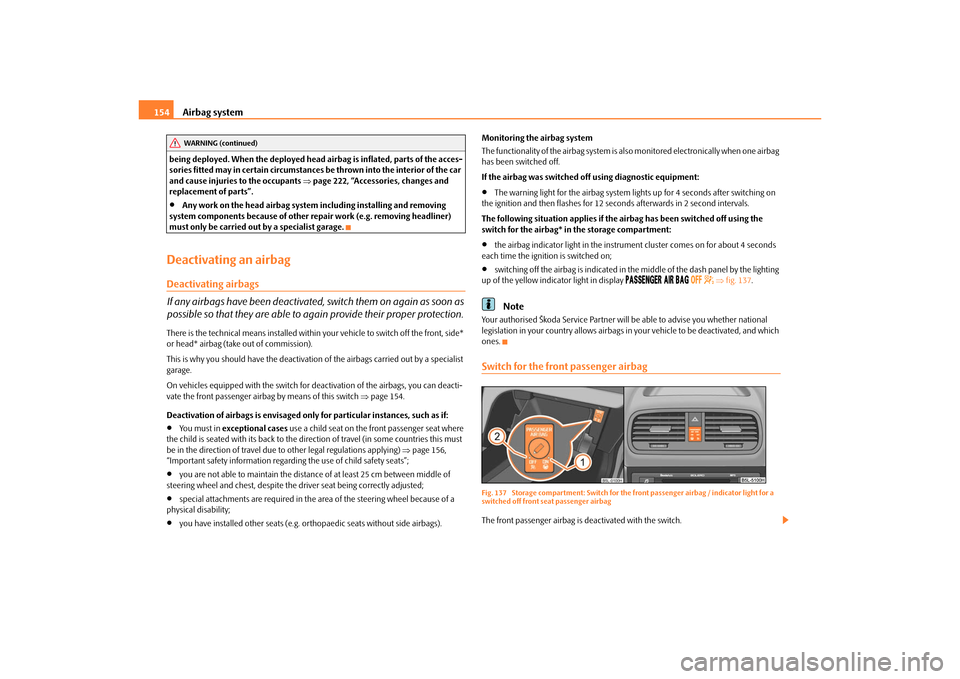
Airbag system
154
being deployed. When the deployed head airbag is inflated, parts of the acces-
sories fitted may in certain circumstances be thrown into the interior of the car
and cause injuries to the occupants page 222, “Accessories, changes and
replacement of parts”.
Any work on the head airbag system including installing and removing
system components because of other repair work (e.g. removing headliner)
must only be carried out by a specialist garage.
Deactivating an airbagDeactivating airbags
If any airbags have been deactivated, switch them on again as soon as
possible so that they are able to again provide their proper protection.There is the technical means installed within your vehicle to switch off the front, side*
or head* airbag (take out of commission).
This is why you should have the deactivation of the airbags carried out by a specialist
garage.
On vehicles equipped with the switch for de activation of the airbags, you can deacti-
vate the front passenger airbag by means of this switch page 154.
Deactivation of airbags is envisaged only for particular instances, such as if:
Yo u m u s t i n exceptional cases use a child seat on the front passenger seat where
the child is seated with its back to the dire ction of travel (in some countries this must
be in the direction of travel due to other legal regulations applying) page 156,
“Important safety information regarding the use of child safety seats”;
you are not able to maintain the distance of at least 25 cm between middle of
steering wheel and chest, despite the driver seat being correctly adjusted;
special attachments are required in the ar ea of the steering wheel because of a
physical disability;
you have installed other seats (e.g. orthopaedic seats without side airbags). Monitoring the airbag system
The functionality of the airbag system is al
so monitored electronically when one airbag
has been switched off.
If the airbag was switched off using diagnostic equipment:
The warning light for the airbag system li ghts up for 4 seconds after switching on
the ignition and then flashes for 12 seco nds afterwards in 2 second intervals.
The following situation applies if the ai rbag has been switched off using the
switch for the airbag* in the storage compartment:
the airbag indicator light in the instrume nt cluster comes on for about 4 seconds
each time the igniti on is switched on;
switching off the airbag is indicated in the middle of the dash panel by the lighting
up of the yellow indicator light in display
fig. 137 .
Note
Your authorised Škoda Service Partner will be able to advise you whether national
legislation in your country allows airbags in your vehicle to be deactivated, and which
ones.Switch for the front passenger airbagFig. 137 Storage compartment: Switch for the front passenger airbag / indicator light for a
switched off front seat passenger airbagThe front passenger airbag is deactivated with the switch.
WARNING (continued)
s2ug.6.book Page 154 Friday, April 9, 2010 2:24 PM
Page 156 of 271

Airbag system155
Using the system
Safety
Driving Tips
General Maintenance
Breakdown assistance
Technical Data
Deactivating an airbag– Switch off the ignition.
– Turn the slot of the airbag switch using the key in the position (OFF ) fig. 137 .
– Check whether the yellow airbag indicator light in display
in the middle of the dash panel lights up when the ignition is turned on fig. 137
- right.
Switching on an airbag– Switch off the ignition.
– Turn the slot of the airbag switch using the key in the position ( ON) fig. 137 .
– Check whether the yellow airbag indicator light in display
in the middle of the dash panel lights up when the ignition is turned on fig. 137
- right. The warning light
goes out 65 seconds after the ignition is switched
on.
The airbag should only be switched off under exceptional circumstances page 154.
Indicator light in display
(airbag switched off)
The airbag indicator ligh t is located in the middle of the dash panel page 154,
fig. 137 - right.
If the front passenger airbag is switched off, the warning light comes on about 4
seconds after the ignition is switched on.
There is a system fault present in the airbag switch off if the indicator light
flashes. Please have the car inspected immediately by a specialist garage.
WARNING
The driver is responsible for whether the airbag is switched on or switched
off.
Only switch off the airbag when the ignition is switched off! Otherwise a
fault can occur in the system for the airbag deactivation.
If the yellow indicator light in display
(airbag
switched off) flashes:
Front passenger airbag is not deployed in the event of an accident!
It is also important to have the system inspected without delay by a
specialist garage.
A2A1
WARNING (continued)
s2ug.6.book Page 155 Friday, April 9, 2010 2:24 PM
Page 170 of 271
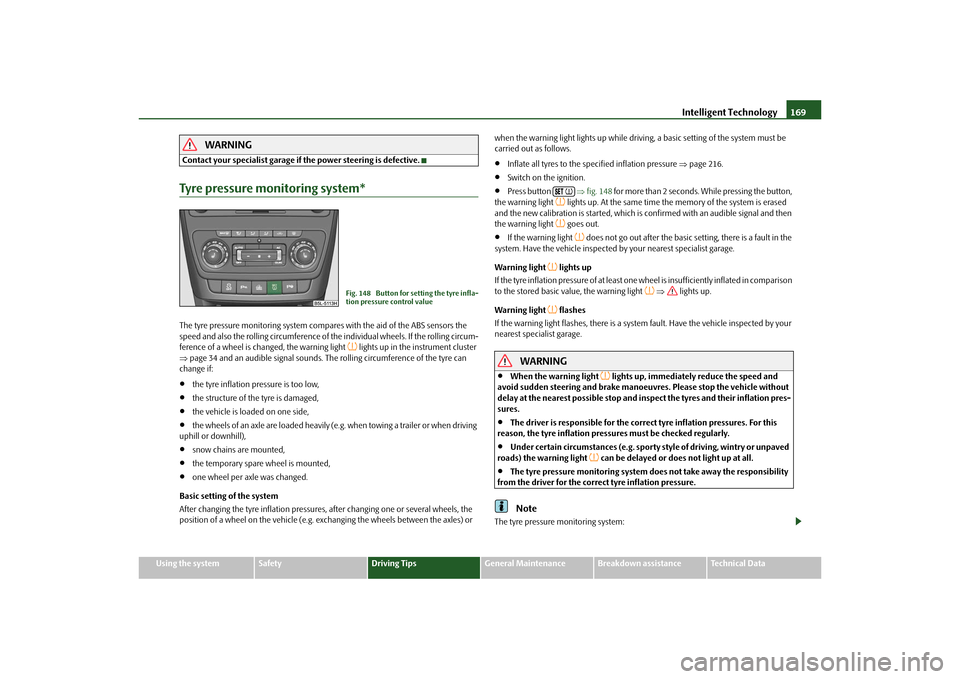
Intelligent Technology169
Using the system
Safety
Driving Tips
General Maintenance
Breakdown assistance
Technical Data
WARNING
Contact your specialist garage if the power steering is defective.Tyre pressure monitoring system*The tyre pressure monitoring system compares with the aid of the ABS sensors the
speed and also the rolling circumference of the individual wheels. If the rolling circum-
ference of a wheel is changed, the warning light
lights up in the instrument cluster
page 34 and an audible sign al sounds. The rolling circumference of the tyre can
change if:
the tyre inflation pressure is too low,
the structure of the tyre is damaged,
the vehicle is loaded on one side,
the wheels of an axle are loaded heavily (e.g. when towing a trailer or when driving
uphill or downhill),
snow chains are mounted,
the temporary spare wheel is mounted,
one wheel per axle was changed.
Basic setting of the system
After changing the tyre inflation pressures, after changing one or several wheels, the
position of a wheel on the vehicle (e.g. exch anging the wheels between the axles) or when the warning light lights up while drivin
g, a basic setting of the system must be
carried out as follows.
Inflate all tyres to the specified inflation pressure page 216.
Switch on the ignition.
Press button fig. 148 for more than 2 seconds. While pressing the button,
the warning light
lights up. At the same time the memory of the system is erased
and the new calibration is started, which is confirmed with an audible signal and then
the warning light goes out.
If the warning light
does not go out after the basic setting, there is a fault in the
system. Have the vehicle inspected by your nearest specialist garage.
Warning light
lights up
If the tyre inflation pressure of at least one wheel is insufficiently inflated in comparison
to the stored basic va lue, the warning light
lights up.
Warning light
flashes
If the warning light flashes, there is a system fault. Have the vehicle inspected by your
nearest specialist garage.
WARNING
When the warning light
lights up, immediately reduce the speed and
avoid sudden steering and brake manoeuvr es. Please stop the vehicle without
delay at the nearest possible stop and in spect the tyres and their inflation pres-
sures.
The driver is responsible for the correc t tyre inflation pressures. For this
reason, the tyre inflation pressures must be checked regularly.
Under certain circumstances (e.g. sporty style of driving, wintry or unpaved
roads) the warning light
can be delayed or does not light up at all.
The tyre pressure monitoring system do es not take away the responsibility
from the driver for the correct tyre inflation pressure.Note
The tyre pressure monitoring system:
Fig. 148 Button for setting the tyre infla-
tion pressure control value
s2ug.6.book Page 169 Friday, April 9, 2010 2:24 PM
Page 172 of 271
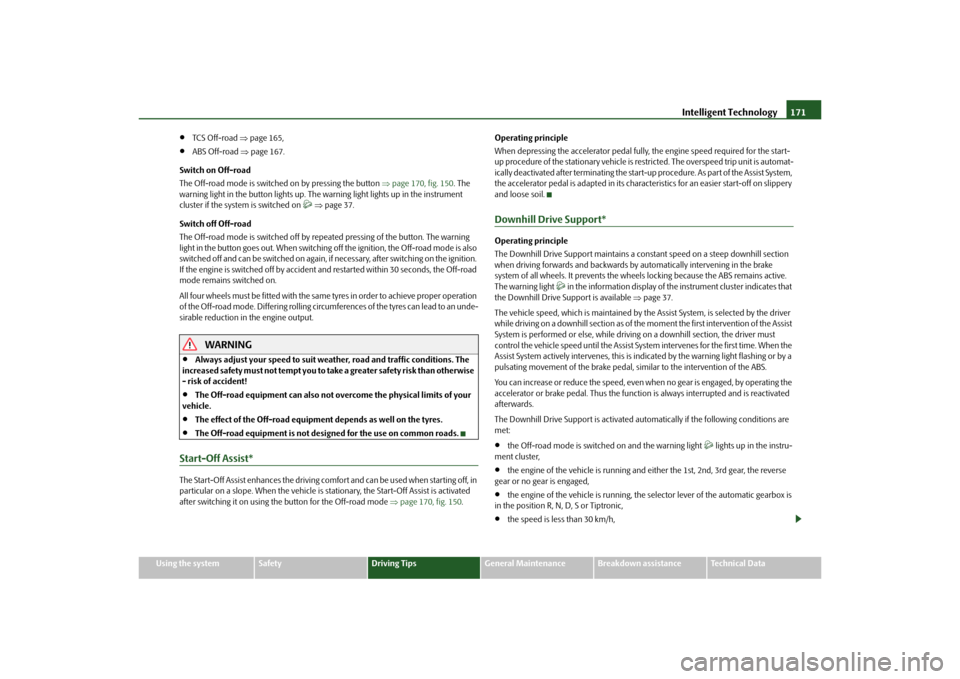
Intelligent Technology171
Using the system
Safety
Driving Tips
General Maintenance
Breakdown assistance
Technical Data
TCS Off-road page 165,
ABS Off-road page 167.
Switch on Off-road
The Off-road mode is switched on by pressing the button page 170, fig. 150 . The
warning light in the button lights up. The warning light lights up in the instrument
cluster if the system is switched on
page 37.
Switch off Off-road
The Off-road mode is switched off by repe ated pressing of the button. The warning
light in the button goes out. When switching off the ignition, the Off-road mode is also
switched off and can be switched on again, if necessary, after switching on the ignition.
If the engine is switched off by accident an d restarted within 30 seconds, the Off-road
mode remains switched on.
All four wheels must be fitted with the same tyres in order to achieve proper operation
of the Off-road mode. Differing rolling circum ferences of the tyres can lead to an unde-
sirable reduction in the engine output.
WARNING
Always adjust your speed to suit weat her, road and traffic conditions. The
increased safety must not tempt you to take a greater safety risk than otherwise
- risk of accident!
The Off-road equipment can also not overcome the physical limits of your
vehicle.
The effect of the Off-road equipment depends as well on the tyres.
The Off-road equipment is not designed for the use on common roads.
Start-Off Assist*The Start-Off Assist enhances the driving comfort and can be used when starting off, in
particular on a slope. When the vehicle is stationary, the Start-Off Assist is activated
after switching it on using the button for the Off-road mode page 170, fig. 150 .Operating principle
When depressing the accelerator pedal fully, the engine speed required for the start-
up procedure of the stationary vehicle is restricted. The overspeed trip unit is automat-
ically deactivated after terminating the start-up procedure. As part of the Assist System,
the accelerator pedal is adapted in its characteristics for an easier start-off on slippery
and loose soil.
Downhill Drive Support*Operating principle
The Downhill Drive Support maintains a cons
tant speed on a steep downhill section
when driving forwards and backwards by automatically intervening in the brake
system of all wheels. It prevents the wheels locking because the ABS remains active.
The warning light
in the information display of the instrument cluster indicates that
the Downhill Drive Support is available page 37.
The vehicle speed, which is maintained by the Assist System, is selected by the driver
while driving on a downhill section as of the moment the first intervention of the Assist
System is performed or else, while driving on a downhill section, the driver must
control the vehicle speed until the Assist System intervenes for the first time. When the
Assist System actively intervenes, this is indicated by the warning light flashing or by a
pulsating movement of the brake pedal, similar to the intervention of the ABS.
You can increase or reduce the speed, even when no gear is engaged, by operating the
accelerator or brake pedal. Thus the function is always interrupted and is reactivated
afterwards.
The Downhill Drive Support is activated auto matically if the following conditions are
met:
the Off-road mode is switched on and the warning light
lights up in the instru-
ment cluster,
the engine of the vehicle is running and either the 1st, 2nd, 3rd gear, the reverse
gear or no gear is engaged,
the engine of the vehicle is running, the selector lever of the automatic gearbox is
in the position R, N, D, S or Tiptronic,
the speed is less than 30 km/h,
s2ug.6.book Page 171 Friday, April 9, 2010 2:24 PM
Page 175 of 271
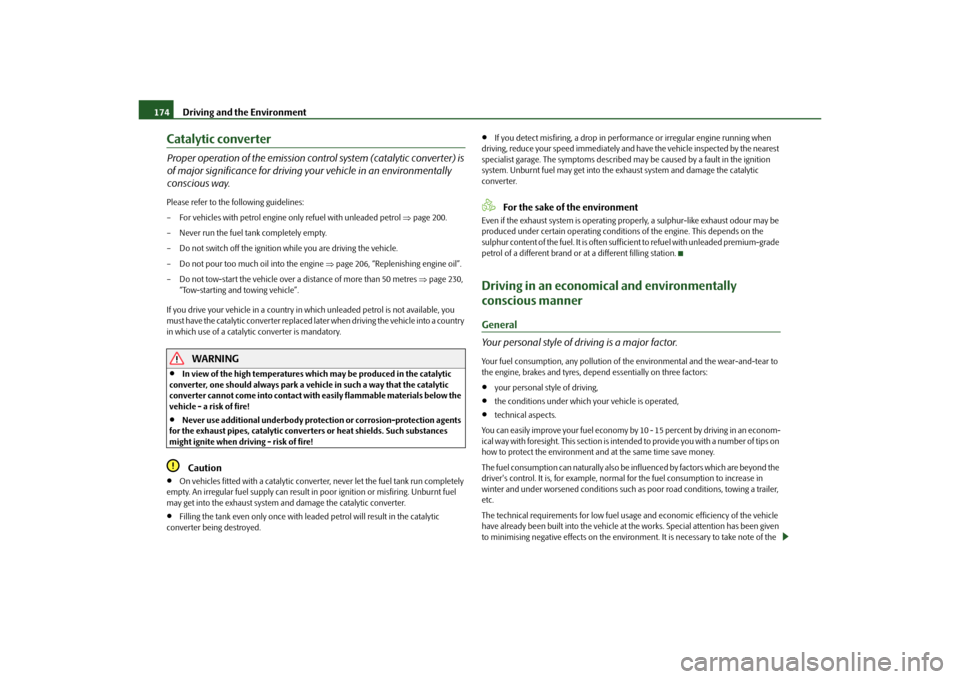
Driving and the Environment
174
Catalytic converterProper operation of the emission cont rol system (catalytic converter) is
of major significance for driving your vehicle in an environmentally
conscious way.Please refer to the following guidelines:
– For vehicles with petrol engine only refuel with unleaded petrol page 200.
– Never run the fuel tank completely empty.
– Do not switch off the ignition while you are driving the vehicle.
– Do not pour too much oil into the engine page 206, “Replenishing engine oil”.
– Do not tow-start the vehicle over a distance of more than 50 metres page 230,
“Tow-starting and towing vehicle”.
If you drive your vehicle in a country in which unleaded petrol is not available, you
must have the catalytic converter replaced la ter when driving the vehicle into a country
in which use of a catalyti c converter is mandatory.
WARNING
In view of the high temperatures which may be produced in the catalytic
converter, one should always park a vehicle in such a way that the catalytic
converter cannot come into contact with easily flammable materials below the
vehicle - a risk of fire!
Never use additional underbody protection or corrosion-protection agents
for the exhaust pipes, catalytic converters or heat shields. Such substances
might ignite when driving - risk of fire!Caution
On vehicles fitted with a catalytic converte r, never let the fuel tank run completely
empty. An irregular fuel supply can result in poor ignition or misfiring. Unburnt fuel
may get into the exhaust system and damage the cata lytic converter.
Filling the tank even only once with leaded petrol will result in the catalytic
converter being destroyed.
If you detect misfir ing, a drop in performance or irregular engine running when
driving, reduce your speed immediately and have the vehicle inspected by the nearest
specialist garage. The symptoms described ma y be caused by a fault in the ignition
system. Unburnt fuel may get into the exhaust system and damage the catalytic
converter.For the sake of the environment
Even if the exhaust system is operating pr operly, a sulphur-like exhaust odour may be
produced under certain oper ating conditions of the engine. This depends on the
sulphur content of the fuel. It is often sufficient to refuel with unleaded premium-grade
petrol of a different brand or at a different filling station.Driving in an economical and environmentally
conscious mannerGeneral
Your personal style of driving is a major factor.Your fuel consumption, any pollution of the environmental and the wear-and-tear to
the engine, brakes and tyres, depend essentially on three factors:
your personal style of driving,
the conditions under which your vehicle is operated,
technical aspects.
You can easily improve your fuel economy by 10 - 15 percent by driving in an econom-
ical way with foresight. This section is intended to provide you with a number of tips on
how to protect the environment and at the same time save money.
The fuel consumption can naturally also be influenced by factors which are beyond the
driver's control. It is, for example, normal for the fuel consumption to increase in
winter and under worsened cond itions such as poor road conditions, towing a trailer,
etc.
The technical requirements for low fuel usage and economic efficiency of the vehicle
have already been built into the vehicle at the works. Special attention has been given
to minimising negative effects on the environment. It is necessary to take note of the
s2ug.6.book Page 174 Friday, April 9, 2010 2:24 PM
Page 195 of 271

Taking care of your vehicle and cleaning the vehicle
194
There are no particular points to note be fore washing your vehicle in an automatic
vehicle wash system other than the usua l precautionary measures (closing the
windows and the sliding/tilting roof etc.).
If you have any particular attached parts fitted to your car - such as spoiler, roof rack
system, two-way radio aerial - it is best to first of all consult the operator of the car
wash plant.
It is important to degrease the lips of the windscreen wiper rubbers after passing
through the automatic vehicle wash system.Washing vehicle by handIt is important to first soften the dirt with plenty of water and rinse it off as thoroughly
as possible before washin g your vehicle by hand.
One should then clean the vehicle using a soft washing sponge, washing glove or a
washing brush and only slight pressure. Work from the top to the bottom - beginning
with the roof. Only place slight pressure on the vehicle paintwork during cleaning Only
use a car shampoo for stubborn dirt.
Wash out the sponge or washing glove thoroughly at short intervals.
Clean wheels, door sills and similar parts last. Use a second sponge for such areas.
Rinse off the vehicle well after giving it a wash and dry it off using a chamois leather.
WARNING
The ignition should always be switched off when you wash your vehicle -
risk of accident!
Protect your hands and arms from sharp-edged metal parts when you are
cleaning the underfloor, the inside of the wheel housings or the wheel trims -
risk of cuts.Caution
Do not wash your vehicle in bright sunlight - risk of paint damage.
Ensure that the jet of water is not aimed di rectly at the locking cylinders or at the
door and panel joints if you spray your vehi cle in winter down with a hose - risk of
freezing.
Do not use any insect sponges, rough kitc hen sponges or similar cleaning products
- risk of damage to the surface of paintwork.For the sake of the environment
Only wash your vehicle at wa shing bays specifically reserved for this purpose. This
ensures that no water which may be contaminated by oil flows into the sewage system.
It is not even permitted to wash your vehicl e in certain areas except at such specific
washing bays.Washing with a high-pressure cleanerWhen you wash your vehicle with a high-press ure cleaner, it is essential to comply with
the instructions for use of the cleaning equi pment. This applies in particular to the
pressure used and to the spraying distance . Maintain a sufficiently large distance to
soft materials such as rubber hoses or insulation material.
On no account use circular spray nozzles or so-called dirt cutters!
WARNING
It is particularly important that you do not clean tyres with circular spray jets.
Visible but also invisible damage to tyres may occur even at a relatively large
spraying distance and if sprayed only for a short time - risk of accident!
Caution
The water containing wax must be no hotter than 60°C, otherwise the vehicle can be
damaged.Wax treatmentGood wax treatment is an effective way of protecting the paintwork from harmful envi-
ronmental influences and minor mechanical damage.
The vehicle must be treated with a high-quali ty hard wax polish at the latest, when no
more drops form on the clean paintwork.
s2ug.6.book Page 194 Friday, April 9, 2010 2:24 PM
Page 198 of 271

Taking care of your vehicle and cleaning the vehicle197
Using the system
Safety
Driving Tips
General Maintenance
Breakdown assistance
Technical Data
Underbody protectionThe underside of your vehicle is protected for life against chemical and mechanical
influences.
One cannot, however, completely rule out damage to the protective layer when
driving so we recommend that you inspect the protective layer on the underside of
your vehicle and on the chassis at certain intervals - this is best done at the beginning
and end of the winter - and to touch up any damaged areas.
The authorised Škoda Service Partners have suitable spray products available as well
as the necessary equipment and are familiar with the instructions for use. It is therefore
best to have such touch-up work or additional corrosion protection measures carried
out by an authorised Škoda Service Partner.
WARNING
Never use additional underbody protection or corrosion-protection agents for
the exhaust pipes, catalytic converters, di esel particle filter or heat shields.
When the engine reaches its operating temperature, these substances might
ignite - risk of fire!Protection of hollow spacesAll the cavities of your vehicle which are at risk from corrosion are protected for life by
a layer of protective wax applied in the factory.
This wax protection does not require to be inspected or re-treated. Please remove any
small amount of wax which flows out of the cavities at high temperatures with a plastic
scraper and clean the spot using petroleum cleaner.
WARNING
Safety and environmental pr otection regulations should observed when using
petroleum cleaner to remove wax - a risk of fire!
Engine compartmentGood corrosion protection is very importan t, particularly in winter when one often
drives over its salt-strewn roads. One should therefore clean the whole engine
compartment before and after the salt spreading period and treat with preservative in
order to prevent the salt from being destructive.
The authorised Škoda Service Partners have the cleaning agents and preservatives
recommended by the manufacturer and also the required equipment.
WARNING
It is necessary to observ e the guidelines given in the chapter before working
on the engine compartment page 204, “Working in the engine compart-
ment”.
Let the engine cool down before cleaning the engine compartment.Caution
Engine cleaning may be only be un dertaken when the ignition is off.
It is recommended to cover the generator before washing the engine compart-
ment.For the sake of the environment
The dirty water produced by washing the engine has washed away petrol, and residues
of grease and oil and should therefore be cleaned by an oil separator. This is why
engine washing should only be undertaken in a specialist garage or at a fueling station
(when these are fitted with the required equipment).Care of the interior of vehiclePlastic parts, artificial leather and clothsYou can clean plastic parts and artificial leather with a moist cloth. You should only
treat such parts with special solvent-free plastic cleaning and care products it does
prove to be adequate.
s2ug.6.book Page 197 Friday, April 9, 2010 2:24 PM